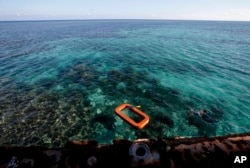ນັກຊ່ຽວຊານກ່າວວ່າ ການສັບປ່ຽນກັນຊ້ອມລົບຂອງທະຫານລະຫວ່າງ ສະຫະ ລັດກັບຈີນໃນທະເລຢູ່ຂົງເຂດເອເຊຍທີ່ມີການຂັດແຍ້ງກັນໃນອາທິດນີ້ ແມ່ນກາຍເປັນເຫດການປົກກະຕິແບບໃໝ່ໄປແລ້ວ ໃນຂະນະທີ່ປັກກິ່ງຫາທາງຄວບຄຸມເສັ້ນທາງເດີນເຮືອ ແລະ ກຳລັງທະຫານຂອງສະຫະລັດຢາກໃຫ້ມັນເປີດກວ້າງສຳລັບໃຫ້ສາກົນນໍາໃຊ້.
ຜູ້ບັນຊາການກຸ່ມກໍາປັ່ນບຸກໂຈມຕີ Theodore Roosevelt Carrier Strike ແລະກຸ່ມກໍາປັ່ນ Makin Island Amphibious Ready Group ຂອງສະຫະລັດໄດ້ດຳເນີນການ “ປະຕິບັດງານໃຊ້ກໍາລັງໂຈມຕີແບບວ່ອງໄວ” ຢູ່ທະເລຈີນໃຕ້ໃນວັນສຸກຜ່ານມາ, ອີງຕາມຜູ້ບັນຊາການກອງທັບເຮືອເຂດປາຊີຟິກຂອງສະຫະລັດກ່າວຢູ່ໃນຖະແຫຼງການສະບັບນຶ່ງທີ່ເຜີຍແຜ່ຜ່ານທາງອອນລາຍ. ຖະແຫຼງການນັ້ນກ່າວວ່າ, ການຊ້ອມລົບຂອງພວກເຂົາເຈົ້າ "ໄດ້ມີຂຶ້ນເພື່ອສະໜັບສະໜູນໃຫ້ ຂົງເຂດອິນໂດ -ປາຊີຟິກມີເສລີພາບ ແລະເປີດກວ້າງ."
ນຶ່ງມື້ຕໍ່ມາ, “ກໍມີລາຍງານວ່າ” ກຸ່ມກໍາປັ່ນບັນທຸກເຮືອບິນ ລຽວໜິງ (Liaoning) ຂອງກອງທັບເຮືອຈີນ ໄດ້ເຂົ້າໄປສູ່ເຂດທະເລດັ່ງກ່າວຈາກທາງໃກ້ໆໄຕ້ຫວັນ, ອີງຕາມການລາຍງານໜັງສືພິມຂອງອົງການຂ່າວ Global Times ທີ່ຕັ້ງຢູ່ປັກ ກິ່ງ. ລາຍງານນັ້ນຕັ້ງຂໍ້ສະເໜີໃຫ້ຮູ້ວ່າ ກຸ່ມກໍາປັ່ນຫລຽວໜິງກຳລັງດຳເນີນການ “ການຊ້ອມລົບ” ຢູ່ໃນທະເລແຫ່ງນັ້ນ.
ໃນຂະນະທີ່ດໍາເນີນການໃນຊ່ວງເວລາທີ່ໃກ້ກັນ ແລະການຊ້ອມລົບຂະໜາດໃຫຍ່ກວ່າປົກກະຕິຂອງສະຫະລັດ ໄດ້ດຶງດູດເອົາຄວາມສົນໃຈຂອງຄົນຢູ່ໃນຂົງເຂດເອເຊຍ, ເຊິ່ງປະເທດອື່ນຫວັງວ່າພວກເຂົາເຈົ້າເຂົ້າກັນໄດ້ກັບປະເທດມະຫາອຳນາດທັງສອງ, ບັນດານັກວິເຄາະກ່າວວ່າການເຄື່ອນໄຫວທາງທະຫານຂອງສອງປະເທດນີ້ ຢູ່ໃນທະເລຈີນໃຕ້ຮູ້ສຶກວ່າກຳລັງກາຍເປັນເລື້ອງປົກກະຕິໄປ ແລ້ວ ແລະຈະສືບຕໍ່ເກີດຂຶ້ນເລື້ອຍໆ.
ທ່ານເອີດົວໂດ ອາຣາໂຣລ (Eduardo Araral), ຮອງສາສະດາຈານສອນທີ່ວິທະຍາໄລ ນະໂຍບາຍລັດຖະບານທີ່ມະຫາວິທະຍາໄລແຫ່ງຊາດຂອງສິງກະໂປກ່າວວ່າ "ມັນມັກຈະເປັນເງົາຂອງການຕີມວຍຂອງລະຫວ່າງສອງປະເທດມະຫາອຳນາດນີ້." "ມັນຄ້າຍກັບວ່າທັງສອງຝ່າຍສົ່ງສັນຍານບອກໃຫ້ ກັນຮູ້ວ່າ 'ຂ້ອຍຢູ່ນີ້ເດີ້ ແລະເຈົ້າສາມາດເຫັນຂ້ອຍແມ່ນບໍ່, ຂ້ອຍເຫັນເຈົ້າໄດ໋' ຄືຈັ່ງຊັ້ນຫລະ, ແຕ່ມັນອາດຈະບໍ່ກາຍເປັນເລື້ອງຮ້າຍແຮງດອກ. ຂ້ອຍຄິດວ່າພວກເຂົາເຈົ້າຈະລະມັດລະວັງກ່ຽວກັບເລື່ອງນັ້ນ.”
ກຳປັ່ນຈີນຈະປາກົດຕົວຂຶ້ນ “ນັບມື້ນັບເລື້ອຍຂຶ້ນ” ໄປພ້ອມໆກັນກັບ “ໂຄງການພັດທະນາກໍາປັ່ນບັນທຸກເຮືອບິນໃນອະນາຄົດ” ຂອງຈີນ ອີງຕາມສຳນັກຂ່າວ Global Times ທີ່ຢູ່ພາຍໃຕ້ການຄວບຄຸມຂອງລັດຖະບານໂດຍອ້າງເຖິງຄໍາເວົ້າ ຂອງນັກວິເຄາະ. ກຳປັ່ນບັນທຸກເຮືອບິນລຳ ທີ 2 ຂອງຈີນທີ່ເຂົ້າມາໃຫ້ບໍລິການໃນປີ 2019 ແມ່ນໄປປະຈໍາຢູ່ທ່າເຮືອແຫ່ງນຶ່ງໃນແຄມຝັ່ງຂອງຈີນ ຢູ່ທະເລຈີນໃຕ້.
ກໍາປັ່ນຂອງກອງທັບເຮືອສະຫະລັດໄດ້ໄປຮອດທະເລຈີນໃຕ້ສອງຄັ້ງແລ້ວນັບຕັ້ງແຕ່ປະທານາທິບໍດີໂຈ ໄບເດັນໄດ້ເຂົ້າຮັບຕຳແໜ່ງ ໃນເດືອນມັງກອນເປັນຕົ້ນມາ ຫຼັງຈາກມີການປະຕິບັດງານ "ເສລີພາບໃນການເດີນເຮືອ" 10 ຄັ້ງ ໃນທະເລແຫ່ງນັ້ນໃນປີກາຍນີ້.
ອ່ານຂ່າວນີ້ເພີ້ມເປັນພາສາອັງກິດຂ້າງລຸ່ມນີ້
Back-to-back military exercises by the United States and China in a contested Asian sea this past week are shaping as a new normal as Beijing seeks control over the waterway and U.S. forces want it open for international use, experts say.
The U.S. Theodore Roosevelt Carrier Strike Group and the Makin Island Amphibious Ready Group carried out “expeditionary strike force operations” in the South China Sea on Friday, the U.S. Pacific Fleet commander said in a statement online. Their exercises “took place in support of a free and open Indo-Pacific”, the statement says.
A day later, the Chinese navy’s Liaoning aircraft carrier task group “reportedly” entered the sea from near Taiwan, the Beijing-based news outlet Global Times reported. It suggested the Liaoning group was doing “drills” in the sea.
While the close timing and unusually large scale of the U.S. exercises caught attention in Asia, where other countries hope to get along with both superpowers, analysts say their military activities in the South China Sea are becoming ominously routine and will keep happening.
“It’s always shadow boxing between these two powers,” said Eduardo Araral, associate professor at the National University of Singapore's public policy school. “It’s more like both sides signaling ‘I’m here and you can see me, I see you’ kind of thing, but they’re probably not coming to blows. I think they will be careful about that.”
Chinese vessels will appear “increasingly more often” in sync with China’s “future aircraft carrier development program”, the state-controlled Global Times said, citing an analyst. A second Chinese aircraft carrier, which entered service in 2019, is based at a port on China’s?? South China Sea coast.
U.S. Navy ships have reached the South China Sea twice since President Joe Biden took office in January following 10 “Freedom of Navigation” operations in the sea last year.
Chinese military vessels are turning up more often as the government in Beijing claims 90% of the sea and hopes to control that waterway as well as the East China Sea before expanding outward, said Alexander Huang, strategic studies professor at Taiwan’s Tamkang University. He said Chinese military officials had set that goal in the 1980s.
Both seas fall within the first island chain, meaning islands such as Taiwan and the Japanese archipelago that extend from Russia to the Malay Peninsula. China would try next, Huang said, for more influence in the second island chain: the southeastern outlying islands of Japan and the Mariana Islands.
“I think the capability that they are striving for or looking at is to have firm sea control within the first island chain and they will have power projection capability to the area between the first and second island chains,” Huang said.
China aims now to “test the limits of the first island chain,” Araral said.
Officials in Washington hope their passages through the South China Sea inspire confidence in five other governments that claim all or parts of it, Araral said. Those are Brunei, Malaysia, the Philippines, Taiwan and Vietnam. The 3.5 million-square-kilometer sea is prized for natural resources including gas, oil and fisheries.
China cites historical usage records to defend today’s claim, including tracts inside the 370-kilometer-wide exclusive economic zones of other countries.
Beijing has slowly occupied contested islets since the 1950s, sometimes with reclaimed land. Today its holdings support airstrips, hangars and radar systems. China has the strongest armed forces among the six claimants, prompting others to look toward the United States for support.
U.S. forces are maintaining the “tempo” of their military exercises to show friendly Asia Pacific governments they are “on guard,” Huang said. Beijing and Washington have vied over the past year for the support of Southeast Asian maritime claimants – China through economic support and the United States by offering military aid. Washington does not claim the South China Sea.
On Tuesday, U.S. Secretary of Defense Lloyd Austin spoke with his Philippine counterpart Delfin Loreanzana by phone to propose measures for deeper defense cooperation, such as “enhancing situational awareness of threats in the South China Sea,” the U.S. Indo-Pacific Command said in a statement online.
The two discussed the South China Sea, including a group of “maritime militia vessels” that China has allowed to moor at the disputed Whitsun Reef.
In Malaysia, the passage of American vessels already seems normal, but the increase in Chinese activity will take some getting used to, said Shariman Lockman, senior foreign policy and security studies analyst with the Institute of Strategic and International Studies in Malaysia.
Malaysia probably won’t protest unless they interfere with Malaysian offshore gas and oil drilling, he said. Oil and gas make up 15% to 40% of government revenue.
“The Chinese presence is (a) relatively new phenomenon for us, but I think we should take it as something that they are going to do from time to time.” Lockman said.





